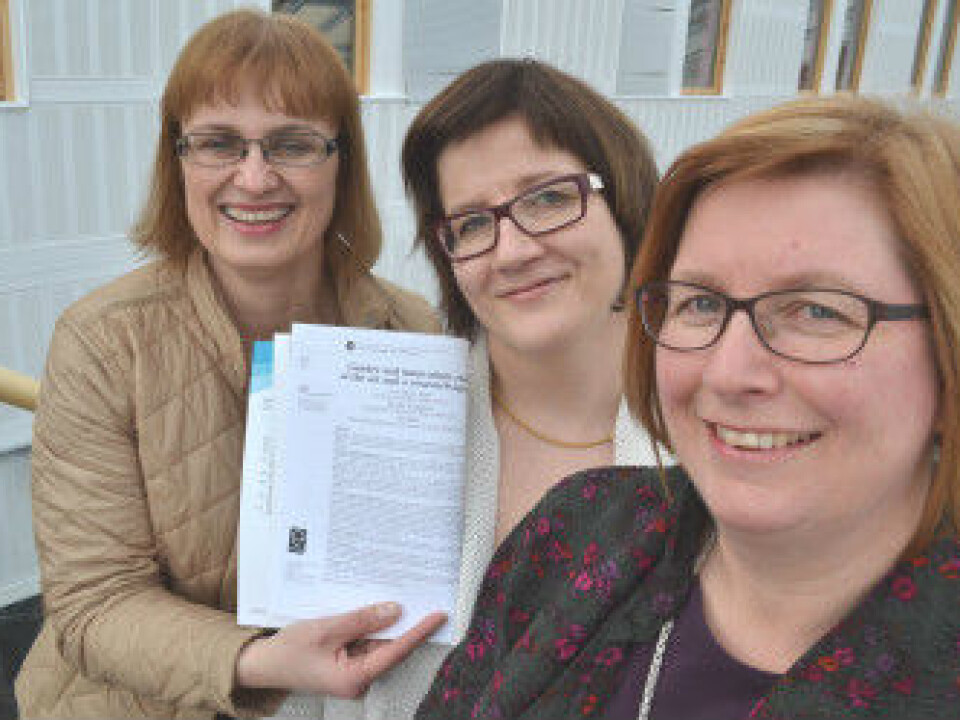An article from KILDEN Information and News About Gender Research in Norway
Gender blind research on innovation
Due to gender stereotypes, some businesses are valued more than others, Norwegian researcher claims.
Denne artikkelen er over ti år gammel og kan inneholde utdatert informasjon.
Society needs innovation and creative entrepreneurs. We need changes, new types of organisations and new technology.
“But most studies on innovation look at products, processes and organisations – not at people,” says Gry Agnete Alsos at the University of Nordland, Norway,
“Hence the gender perspective disappears,” she says .
Together with Elisabet Ljunggren at Nordland Research Institute and Ulla Hytti at the University of Turku, Finland, she has examined gender and innovation and its state of the art.
Their recently published article “Gender and innovation: state of the art and a research agenda”, was nominated Highly Commended Paper of 2013 by International Journal of Gender and Entrepreneurship (IJGE). The publishing company Emerald Group refers to the article as one of the most important articles in 2013.
“Innovation is a major political issue which receives wide support in society today. But this support is much more advantageous for male dominated businesses – both in terms of financial support and research. The technological industry especially is regarded as being innovative whereas businesses within the service industry, for example, are ignored,” says Alsos.
Persuaded the journal
Alsos and Ljunggren have been involved in the Norwegian Research Council’s initiative to invest in research and innovation in Norwegian regions. The gender perspective has been essential. In this connection the researchers realised that very little research has been carried out on gender and innovation in Europe in general. Sweden is the only exception.
Since then they have worked on the issue and they have established gender and innovation as a separate topic at larger international conferences. After some persuasion, they were also given the opportunity to guest edit their own special issue of the journal IJGE in 2013.

According to Alsos, gender matters in terms of how we perceive processes and innovation.
“If innovation is defined as something related to engineers and leadership, then we look only at engineers and leaders. And among them there is a majority of men.”
“Perhaps we would have seen other innovative ideas than what we see today if we were looking at places in which there are more women,” says Alsos.
Today a lot of attention is paid towards innovation in the public sector due to a lack of work force and a need for efficiency in the public services. Technological solutions are often applied in order to solve the problems. But it may be a good idea to look at how the women within the sector are working, claims Alsos.
“Employment in the public sector would not have been as high without the women’s entry to the labour market. And even though there is still a need for more work force, many employees work part time against their will.”
“If we look at how women in this sector work it is possible that technology mightn’t be the whole solution to the problem. Rather one should find other ways to use the work force which is already there.”
Ignored in studies on innovation
It is primarily male dominated industries such as technology, IT and engineering which are regarded as innovative, according to the researchers.
Statistics Norway carries out an innovation survey every second year, but only certain industries are included. Many of the service industries are left out of the survey and tourism wasn’t included until 2012.

“But there is a lot of innovation going on in these industries as well,” says Alsos.
An example is the entrepreneur Inger Ellen Nicolaisen and her huge success with the largest Nordic hair dressing company Nikita. This is a type of innovation which is not taken into account in the surveys.
“Nicolaisen has performed what we call organisational innovation – she has changed the entire concept and the way people perceive the industry," Alsos says.
Rather than establishing one small hairdressing salon which sells products from other suppliers, she has established and developed a chain of hairdressing salons with its own label as well as a privately owned hairdressing school.
Innovation is also taking place within the adventure industry and commerce, but many people do not perceive it as innovation.
“One example is the extreme sport industry which constantly develops new types of product packages with various adventure holidays. In general, the adventure businesses experience pressure and demand for new offers. Thus the industry is in constant need for changes and development, but not necessarily major developments such as new, ground-breaking technology,” Alsos explains.
What may be the consequences when certain types of innovation are not included in the surveys?
“It may be significant in terms of how much attention is directed at innovation in these industries and in terms of what is perceived as innovation. This affects political attention, how young people regard the various sectors as an attractive future work place and the framework conditions in the various industries,” says Alsos.
PhD students at the Norwegian research school in innovation (PIMS) said recently that the term innovation needs to be demystified in order to attract women to the field.
Material on gender scarce
In order to examine more closely the amount of research which exists in the field, the researchers made searches in international databases.
Among more than 100,000 articles, only approximately 2,5 per cent, 2445 in total, contained the word gender. 4037 articles contained the word women.
“We found gender and women mentioned particularly in journals on nursing. Within this field they are more concerned with gender in regard to innovation than they are in other health related journals.”
Many of the articles only mention the terms, but they don’t focus on the particular subject.
Only 615 articles contained both innovation and gender, whereas 1306 articles contained the words innovation and women. The majority of these articles are within medicine, nursing or psychology.
“We also found few articles on gender and innovation in journals on entrepreneurship which is a field in which there already exists a lot of research with gender perspectives.”
Innovative women not heard
Gender is mostly used in research on innovation when there’s a focus on differences and similarities between women and men. This is often quantitative research which compares and contrasts how women and men contribute to innovation in the various industries.
“For instance, studies have shown that male researchers contribute more than female researchers when it comes to cooperation within the business sector,” says Alsos.
“This type of empirical research is still important, since there is so little research on innovation which has a gender perspective. But it is also important to take a step forward and try to understand how gender may affect various processes,” she adds.
The Norwegian researchers Lene Foss, Kristin Woll and Mikko Moilanen showed in a study from 2013 that women have as many ideas to new solutions and products as men, but women are not heard as often as men.
This study also showed that women receive less support from their colleagues when it comes to bringing the ideas to fruition.
“Here, the researchers look at what is going on in the big businesses and on how access to new ideas is attained. They look at formal structures, what positions are occupied by men and women and the informal structures. Who are being heard and who possess the competence which is regarded as relevant?”
The researchers’ most important message is that gender is a significant factor which needs to be drawn attention to on various levels in this field of research.
“One thing is to take notice of the individuals, but it's equally important to uncover the power structures behind them,” says Alsos.
The Nordic countries more concerned with gender
While working on their edition of the journal, the researchers noticed that the Nordic countries are a few steps ahead as regards research on gender and innovation. A majority of the contributions came from these countries.
The Swedes in particular are ahead. They noted the connection between innovation and gender as early as in 2001. The Swedish authority on innovation, VINNOVA, initiated the program Genus och innovation [Gender and Innovation] which intends to develop and strengthen gender research in Sweden.
“This imbalance is nevertheless surprising since the Nordic countries are not prominent as regards research on innovation in general. The most prominent contributors in this field are the U.S., United Kingdom, Australia, and Canada,” says Alsos.
Hoping for more attention
The Emerald Group publishes various specialised journals within narrow fields of research. Each year they select some of the best articles from their journals. These articles are promoted by the publisher and made accessible for everybody throughout May.
It has been exiting for Alsos, Ljunggren, and Hytti to achive top ranking.
“It confirms that we have done a good job. We have received a lot of positive feedback from colleagues and other researchers. Moreover, it is our wish that more scholarly attention is paid toward this subject.”
The three researchers have started working on a handbook on gender and innovation. Alsos is hoping that this will make future research look more at gender in the innovation processes.
“Gender stereotypes telling us that men are more innovative and active contribute to making some businesses more valuable than others. We need to keep these types of mechanisms in mind,” she says.
Translated by: Cathinka Dahl Hambro

































